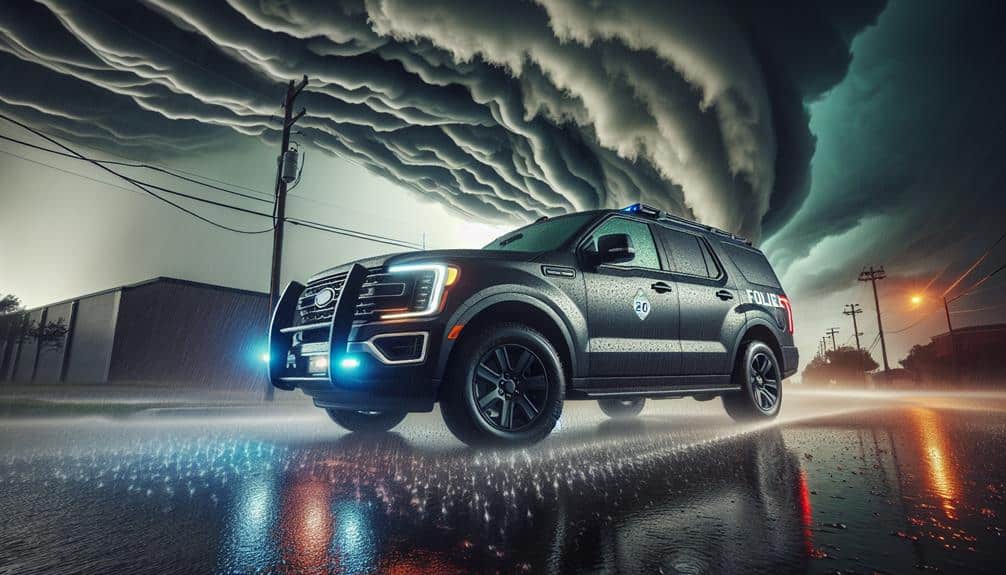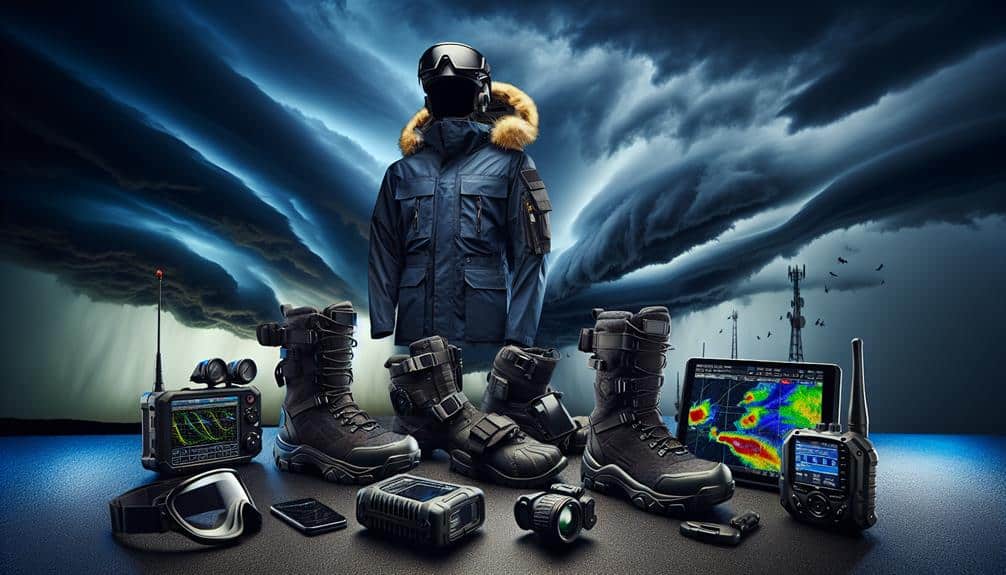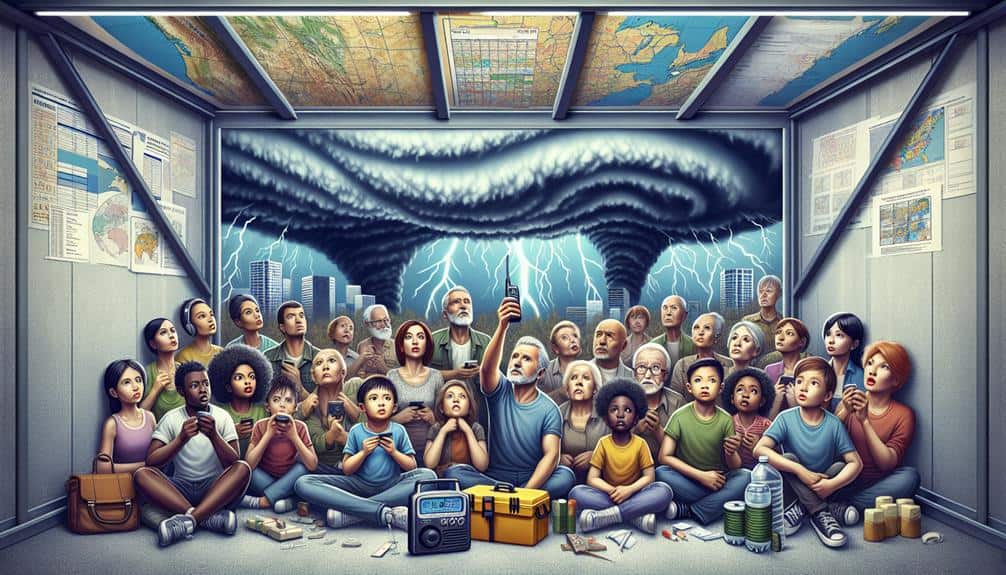As urban chasers maneuvering through unpredictable storms, we prioritize data-driven protocols and advanced tools to guarantee safety. First, we identify and validate safe zones by analyzing structural integrity and optimizing evacuation routes. We continuously monitor weather updates using radar systems and real-time data from automated stations. Our emergency kits are stocked with essentials like a multi-function knife and water purification tablets. We maintain our vehicles rigorously to preempt malfunctions and use GPS and satellite phones for reliable communication. Our team coordination relies on real-time data sharing and centralized command, guaranteeing swift, effective responses. Next steps will deepen strategic insights and practical tips.
Key Points
- Utilize mobile weather apps and radar systems for real-time storm tracking and updates.
- Identify and validate safe zones based on structural integrity, capacity, and accessibility.
- Establish and communicate optimized evacuation routes to minimize traffic bottlenecks.
- Equip with essential emergency kits including first aid supplies, multi-tool, flashlight, and water purification tablets.
Identify Safe Zones
To secure the highest level of safety during urban chases, we need to systematically identify and map out designated safe zones within the city. By relying on GIS (Geographic Information Systems) technology, we can create accurate, real-time maps that highlight safe shelters and evacuation routes. These maps will be vital in guiding us to secure locations when severe weather threatens.
Our first task involves compiling data on potential safe shelters, such as reinforced public buildings, underground facilities, and specially designated storm shelters. We'll analyze their structural integrity, capacity, and accessibility to guarantee they meet safety criteria. By cross-referencing this data with population density statistics, we can prioritize areas that require more robust evacuation plans.
Next, we need to establish and validate evacuation routes. Using traffic flow simulations and historical data on urban congestion, we can optimize these routes to facilitate quick and efficient movement. Our goal is to minimize bottlenecks and guarantee that everyone has a clear path to safety.
Use Reliable Communication
Securing the effectiveness of our evacuation plans requires the establishment of robust communication channels that provide real-time updates and alerts to all team members and the public. Reliable communication is the backbone of any successful emergency response strategy.
Let's focus on four critical elements to guarantee we stay connected and informed:
- Emergency Contacts: Maintain an updated list of emergency contacts, including local authorities, hospitals, and utility companies. This secures that we can quickly relay information and receive assistance when needed.
- Signal Devices: Equip all team members with signal devices such as two-way radios, satellite phones, and GPS trackers. These devices should be tested regularly to confirm functionality under diverse conditions, including power outages and network failures.
- Communication Protocols: Develop and train everyone on standardized communication protocols. This includes using specific codes or phrases to convey urgency, location, and status updates, securing clarity and minimizing misunderstandings during high-stress situations.
- Data-Driven Alerts: Utilize data from meteorological agencies and real-time sensors to create automated alerts. These alerts should be disseminated through multiple channels, including SMS, email, and social media, to reach the widest audience possible.
Monitor Weather Updates
We must prioritize monitoring weather updates by leveraging real-time alerts and data from trusted weather sources. Our protocol necessitates frequent updates to guarantee our response strategies are timely and accurate.
Real-Time Alerts
Monitoring weather updates in real-time is crucial for urban chasers to make informed decisions and safeguard safety during operations. By leveraging cutting-edge technology, we can enhance our emergency response and improve our risk management strategies. Real-time alerts provide us with the precision needed to track severe weather patterns and take immediate action.
To effectively monitor weather updates, we need to focus on several key practices:
- Mobile Weather Apps: These apps offer instant alerts and localized forecasts, keeping us updated on any sudden changes in weather conditions.
- Radar Systems: High-definition radar systems enable us to visualize storm movements and predict their impact zones with scientific accuracy.
- Automated Weather Stations: Placing these stations in strategic urban locations allows for continuous data collection, providing us with real-time temperature, humidity, and wind speed readings.
- Emergency Communication Networks: Establishing robust communication channels ensures that emergency response teams and urban chasers can relay critical information swiftly and efficiently.
Trusted Weather Sources
To harness the power of real-time alerts effectively, we must rely on trusted weather sources that provide accurate and timely information. Utilizing weather app recommendations such as RadarScope and Storm Shield guarantees we receive high-resolution radar data and important alerts. These apps are essential tools for urban chasers, offering features like real-time storm tracking and advanced warning systems.
Online radar tools, including the National Weather Service's radar and Weather Underground, offer thorough, up-to-date radar imagery. These tools provide detailed visualizations of storm development, helping us anticipate severe weather conditions. By integrating these resources into our monitoring routines, we can make informed decisions and take timely action.
Meteorologist insights are another critical component. Following expert meteorologists on social media platforms or through their professional websites can provide nuanced interpretations of weather data that automated systems might miss. Their analyses often include localized forecasts and emerging weather patterns vital for urban chasers.
Lastly, weather blog reviews are valuable for evaluating the effectiveness of various tools and apps. Blogs like Weather Watch and Severe Weather Europe offer in-depth reviews and user experiences, helping us select the best resources for our needs. By leveraging these trusted sources, we stay ahead of the storm, ensuring our safety and freedom.
Update Frequency
Consistently checking for weather updates at frequent intervals guarantees we stay informed about any rapid developments or sudden changes in storm activity. By leveraging the latest technology advancements in weather tracking, we can optimize our emergency response and preparedness training. Accurately timed updates safeguard we make well-informed decisions, minimizing risks and maximizing safety.
To effectively monitor weather updates, we should adhere to the following protocol:
- Set a Routine: Establish a fixed schedule for checking updates. Ideally, monitor weather conditions every 15 to 30 minutes during active storm periods.
- Utilize Multiple Sources: Cross-reference data from various reliable meteorological sources. Combining information from radar systems, satellite imagery, and weather apps enhances accuracy.
- Implement Alerts: Enable automated alerts on mobile devices and computers. These real-time notifications can provide essential information instantly, allowing us to react promptly.
- Analyze Trends: Review and interpret the patterns in weather data. Understanding the trajectory and intensity of storms helps us anticipate changes and prepare accordingly.
Staying vigilant through consistent weather tracking empowers us with the freedom to act decisively during emergencies. By incorporating these strategies, we bolster our preparedness training and emergency response capabilities, safeguarding we're always one step ahead of the storm.
Emergency Kit Essentials
As urban chasers, we must prioritize assembling an emergency kit containing essential survival tools, first aid supplies, and reliable communication devices.
Statistically, having these essentials can increase our survival rate by up to 50% in high-risk situations.
Ensuring our kit is thorough and up-to-date is a crucial step in our preparedness protocol.
Vital Survival Tools
An effective emergency kit contains essential tools like a multi-function knife, first aid supplies, a flashlight, and water purification tablets to guarantee urban survival. These items provide the foundation for our emergency response strategies, allowing us to maintain shelter options and ensure hydration and safety.
For optimal preparedness, our emergency kit should include:
- Multi-function knife: This versatile tool aids in food preparation, cutting materials for shelter, and self-defense.
- Flashlight with extra batteries: Reliable illumination is crucial for night navigation strategies and signaling for help.
- Water purification tablets: Securing access to clean water is crucial for hydration and health, especially when local water supplies may be compromised.
- Portable shelter: Compact and lightweight, options like a thermal blanket or a small tent can provide immediate protection from the elements.
These tools are scientifically chosen based on their utility, durability, and efficiency in urban survival scenarios. Having a well-stocked kit empowers us to navigate through crises with greater autonomy and confidence.
Our focus on precision and practicality ensures that every item serves multiple functions, enhancing our capacity to respond swiftly and effectively in emergency situations. This approach not only maximizes our survival gear efficiency but also supports our inherent desire for freedom and self-reliance.
First Aid Supplies
To ensure immediate response to injuries during urban emergencies, our first aid supplies must include sterile bandages, antiseptic wipes, adhesive tape, and a CPR mask. These items form the core of our emergency response kit, ensuring we can administer essential medical treatment promptly.
Sterile bandages and antiseptic wipes are essential for preventing infection, a leading cause of complications in untreated wounds. Adhesive tape secures dressings in place, allowing us to move freely without compromising wound care.
Additionally, a CPR mask is crucial for safe and effective resuscitation, reducing the risk of transmitting infectious diseases. Our first aid kit should also contain nitrile gloves, which provide a barrier against contaminants and are necessary for maintaining hygiene during medical treatment.
We include a digital thermometer for accurate temperature readings, which can indicate the severity of medical conditions. Pain relief is another important aspect; therefore, our kit includes ibuprofen or acetaminophen. We should also carry tweezers and scissors for removing debris and cutting bandages, respectively.
Communication Devices
Effective communication tools are necessary in our emergency kit for maintaining contact during urban crises. In the chaos of a storm, reliable communication can be the difference between safety and disaster. We need to make sure that our kit includes tools that provide strong, uninterrupted connectivity.
Here are four essential items to take into account:
- Satellite Phones: These devices provide a lifeline when traditional cell networks fail. Their capability to connect via orbiting satellites makes them indispensable for reliable communication with emergency contacts.
- Signal Devices: Whether it's a whistle, flare, or radio transmitter, signal devices are crucial for drawing attention in low-visibility conditions. They help guarantee we're locatable by rescue teams.
- GPS Tracking Units: These units are vital for real-time location tracking. They allow us to send our coordinates to emergency responders, facilitating quick and efficient rescue operations.
- Two-Way Radios: Known for their durable design and long battery life, two-way radios guarantee we can maintain communication within our team and with external aid without relying on cellular networks.
Vehicle Safety Measures

Ensuring vehicle safety measures involves rigorous adherence to standardized protocols and regular maintenance checks to prevent malfunctions during urban chase operations. We can't emphasize enough the importance of defensive driving when maneuvering through unpredictable urban environments. It's paramount that we anticipate potential hazards and prepare for sudden changes in road conditions. Defensive driving techniques such as maintaining safe distances, observing speed limits, and being vigilant of pedestrians and other vehicles are essential.
Our vehicle maintenance regimen must be stringent and data-driven. Regularly scheduled inspections and servicing guarantee that our vehicles are mechanically sound. This includes checking tire pressure, brake systems, fluid levels, and electrical systems. Utilizing diagnostic tools, we can preemptively identify and address issues before they escalate, thereby mitigating the risk of operational failures during critical moments.
Additionally, we equip our vehicles with advanced safety technologies like anti-lock braking systems (ABS), traction control, and stability control. These systems not only enhance performance but also provide layers of safety, allowing us to execute our tasks with precision and confidence.
Team Coordination Tactics
For peak performance during urban chase operations, we utilize advanced communication systems that facilitate real-time coordination among team members. Effective team communication is crucial for successful navigation and emergency response in high-risk urban environments. Leveraging cutting-edge technology and data-driven strategies, we guarantee our teams operate with precision and efficiency.
To streamline our operations, we adhere to the following key tactics:
- Real-Time Data Sharing: Utilizing GPS and weather monitoring applications, we share live updates on storm trajectories and potential hazards. This guarantees all team members have access to the same critical information.
- Centralized Command: A designated command center coordinates all team activities, providing directives based on the latest data. This centralized approach minimizes confusion and enhances our collective response time.
- Redundant Communication Channels: We employ multiple communication methods, including satellite phones, two-way radios, and secure messaging apps. This redundancy guarantees continuous contact, even if one system fails.
- Role-Specific Protocols: Each team member has defined roles and responsibilities, from data analysis to on-ground logistics. Clear delineation of duties allows for swift and effective emergency response.
Post-Storm Assessment
After the storm passes, we conduct a thorough post-storm evaluation to assess structural damage, environmental impact, and data accuracy.
First, we systematically inspect buildings for compromised integrity, documenting any structural damage with high-quality imagery and detailed notes. This data is crucial for a detailed damage assessment and aids in the development of recovery planning.
Next, we evaluate the environmental impact. Using geospatial analysis tools, we map affected areas, identifying changes in topography, vegetation loss, and water contamination levels. This spatial data helps us understand the storm's broader ecological footprint and guides targeted environmental recovery efforts.
Precision in data collection is essential. We cross-reference our field data with meteorological records and satellite imagery to ensure accuracy. We deploy drones equipped with LIDAR technology for precise topographic mapping and use GIS software to overlay multiple data sets. This integrated approach ensures our damage assessment is both thorough and accurate.
Frequently Asked Questions
What Qualifications Are Needed to Become an Urban Storm Chaser?
To become urban storm chasers, we've got to meet specific training requirements and have varied experience levels. We need meteorological knowledge, technical skills in data analysis, and field experience to safely and accurately track urban storms.
How Do You Handle Encounters With Law Enforcement During a Chase?
When push comes to shove, we follow our protocol for law enforcement interactions. We use de-escalation techniques, assert our legal rights, and guarantee all data is documented. Staying calm and informed keeps us free to chase safely.
What Are the Ethical Considerations When Filming Storm Footage?
When filming storm footage, we must prioritize privacy concerns and obtain consent. Avoid sensationalism; guarantee accuracy by cross-checking meteorological data. Our ethical responsibility includes respecting individual freedom while documenting storm phenomena scientifically and responsibly.
How Can Storm Chasers Support Local Emergency Services?
Like gears in a well-oiled machine, we can support local emergency services through community engagement, disaster response, and mutual aid. By improving emergency coordination, we guarantee timely, effective actions, fostering resilience and freedom within our communities.
What Insurance Options Are Available for Storm Chasers and Their Equipment?
For storm chasers, equipment coverage and liability protection are essential. Coverage options include all-encompassing policies for gear and personal liability. Insurance requirements might vary, but ensuring we're protected allows us to operate freely and securely.


